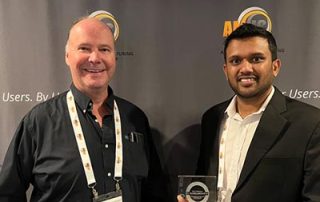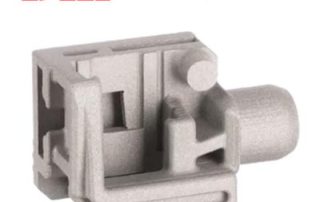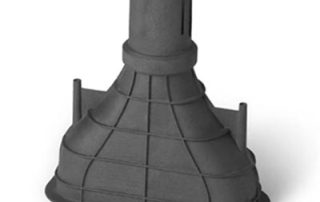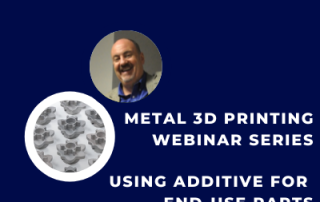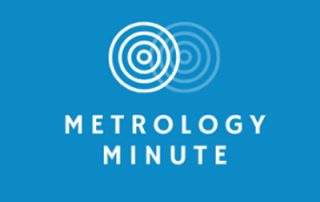AMUG Announces Scholarship Recipients
AMUG Awards the Guy E Bourdeau Scholarship to Akila Udage Rob Hassold, Cimquest Founder is pictured above with scholarship recipient Akila. The Additive Manufacturing Users Group (AMUG) has announced the recipient of its Randy Stevens Scholarship for educators in Additive Manufacturing and its Guy E Bourdeau Scholarship for students in Additive Manufacturing. The Guy E Bourdeau Scholarship is sponsored by Cimquest and recognizes students who demonstrate passion and vision for Additive Manufacturing. This year's winner was Akila Udage. Akila Udage was exposed to Additive Manufacturing while pursuing his master’s degree at the Lighting Research Center (LRC) at RPI. As a graduate research assistant, Udage’s work focused on integrating Additive Manufacturing into LED lighting systems. As part of his research, Udage has been analyzing the advantages and challenges of developing structural, thermal, electrical, and optical components for LED systems using Additive Manufacturing. Udage’s efforts on additively manufactured optics focus on the building of novel lenses for illumination applications, and he has been involved in the characterization of additively manufactured reflective and transmissive optical components. He has also been developing additively manufactured antennas and evaluating the effect of Additive Manufacturing properties on electrical traces. Udage has also been studying the thermal properties of [...]
3D Printing a Sensor Part with Desktop Metal
This blog post will take a look at a part that we recently printed on the Desktop Metal Shop System and then finished machined in our CNC manufacturing lab. The holder shown above is used to fixture multiple sensors for taking measurements in industrial equipment. It was printed in 17-4 PH stainless steel on the Shop System with a technology known as metal binder jetting. This process uses a binding agent to bond loose metal powder and defines part geometry. The printed parts are then placed in a shop-safe furnace for batch sintering. Final parts are fully dense and are near-net shape right out of the furnace. The intricate geometry of this sensor holder makes it an ideal candidate for metal 3D printing. More specifically some of the features like the deep narrow slots would require processes other than CNC to be formed such as burning with electrodes or designed as a casting. Obviously, these additional processes will add time and cost. Since these parts are near-net shape, some critical faces were needed to machine for flatness and or critical dimensions. Therefore, our original set-up strategy for these surfaces was to create two fixtures that were also 3D printed. One to hold the [...]
New Formlabs Nylon 12 Glass Filled Powder 3D Printing Material
Let’s take a look at the new Formlabs Nylon 12 Glass Filled powder 3D printing material. As applications for 3D printing continue to evolve, engineers are requiring a wide palette of materials to meet their needs. And with new gaps in supply chains appearing every day, there’s an increasing demand for functional in-house production. Formlabs Nylon 12 Glass Filled on the Fuse 1 can help make in-house production a reality. Here are some of the key characteristics. Nylon 12 GF has a high stiffness and thermal stability. This is great for companies in automotive, aerospace, and product development, either for functional prototyping or small batch production. This material also has high dimensional accuracy and low warpage. The dimensional accuracy stays consistent at elevated temperatures, making it perfect for testing under harsher environments. Medical manufacturers can also benefit from Nylon 12 GF. Medical devices, brackets, and enclosures are all ideal applications. Replacement parts for machinery are another great use that virtually any industry can benefit from. As you can see, Nylon 12 GF enables manufacturers to take control over their means of production. Ideal for parts that require high rigidity and thermal stability, companies can create industrial-grade parts in-house, instead of relying on outsourcing [...]
Production Metal 3D Printing – Webinars on Demand
Production Metal 3D Printing- Part 3 in the Acceleration of Metal 3D Printing Series This is a three part webinar series, culminating with a live event in New Jersey on April 28th. Metal Additive Manufacturing has become the hottest growth engine in the 3D printing Space. With its increased accessibility, variety of technologies, and breadth of material options, metal additive can give you an edge in highly competitive marketplaces. In Part 3 we'll dive deep into production Metal 3D printing, from hundreds of parts all the way to tens of thousands of parts. We'll show use cases of companies using production to gain a major edge on the competition, and how it can open up entire new applications for your business. Dave Macfie, Cimquest's Director of 3D Printer Sales will be presenting along with special guest, Nate Higgins, Co-Founder of FreeFORM Technologies. https://cimquesttv.wistia.com/medias/9w5qtbtcsx?embedType=async&videoFoam=true&videoWidth=640
Introducing the UE PRO Laser Scanner
The specs and capabilities of the incredible new UE PRO laser handheld scanner are way-beyond what we anticipated. With an accuracy of +/- 20 microns (+/-.00078”) and a maximum resolution of 50 microns in standard mode and an incredible 10 microns in “fine mode,” this handheld scanner sets brand new benchmarks in our industry. Scanning speed is an incredible 1.8 million points/sec. This is accomplished by the 13 crossing lasers (26 lasers, total). A new 5-laser mode was introduced for fine detail scanning. Scanning in fine detail (10 micron resolution) allows enables the user to capture incredible detail. The UE Pro also offers optional, built-in photogrammetry, greatly reducing the volumetric error expected when scanning very large objects. Additionally, Shining’s implementation of photogrammetry doesn’t require the capture of still photos or even the use of photogrammetric targets. Two scale bars are provided with the scanner and the user simply needs to include the bars in their collection of targets. Watch the YouTube video below for more details and contact Joel Pollet with any additional questions.
AMT PostPro Chemical Vapor Smoothing is a Game Changer for Custom 3D Printed Prosthetics
A reprint from 3D Printing Industry Automated post-processing systems manufacturer Additive Manufacturing Technologies (AMT) has deployed its PostPro chemical vapor smoothing technology to improve the surface finish, comfort, and durability of 3D printed prosthetics. Prosthetic device manufacturer Proteo turned to AMT for the post-processing of its 3D printed DuoSocket prosthetic, which had been customized for a patient who had undergone a limb reamputation and for whom the device was still not comfortable or durable enough to use, due to the shape of the stump. The 3D printed DuoSocket prosthetic post-processed using AMT’s PostPro technology. Photo via AMT. The firm made use of AMT’s PostPro chemical vapor smoothing system to improve the surface finish of the device in order to make it more comfortable to wear, while also increasing the stability and durability of the prosthetic to enable the patient to continue his normal physical activities, such as cycling and football. After reamputation, the patient’s stump was a particularly challenging shape to fit the prosthetic. Photo via AMT. PostPro chemical vapor smoothing Since its founding in 2017, AMT has processed over six million 3D printed parts and delivered its post-processing systems to more than 25 countries across the globe. Shortly [...]


